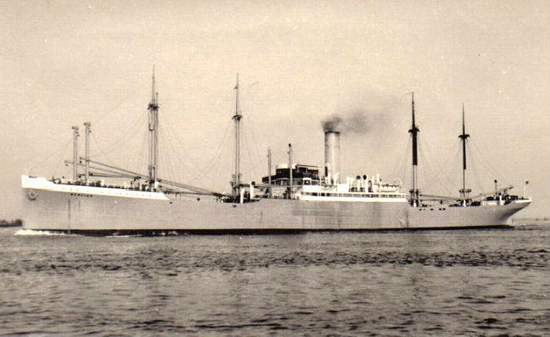Mercier
Belgian Steam merchant

| Name | Mercier | ||
| Type: | Steam merchant | ||
| Tonnage | 7,886 tons | ||
| Completed | 1919 - Bremer Vulkan, Vegesack | ||
| Owner | Compagnie Maritime Belge (Lloyd Royal) SA, Antwerp | ||
| Homeport | Antwerp | ||
| Date of attack | 10 Jun 1941 | Nationality: | |
| Fate | Sunk by U-204 (Walter Kell) | ||
| Position | 48° 30'N, 41° 30'W - Grid BC 6129 | ||
| Complement | 68 (7 dead and 61 survivors). | ||
| Convoy | OB-330 (dispersed) | ||
| Route | Liverpool (2 Jun) - Halifax - Montreal | ||
| Cargo | Ballast, 1000 bags of mail and training aircraft as deck cargo | ||
| History | Launched in November 1915 as Erfurt for Norddeutscher Lloyd, Bremen. Completed in April 1919 for The Shipping Controller (Lawther, Latta & Co, London). 1920 transferred to the Belgian Government as war reparation and 1921 renamed Mercier for Lloyd Royal Belge SA, Antwerp. | ||
| Notes on event | At 02.48 hours on 10 June 1941 the unescorted Mercier (Master Maurice Lambé), dispersed from convoy OB-330 on 7 June, was hit by one of two torpedoes from U-204 when steaming on a non-evasive course at 12 knots about 450 miles east of St. John’s, Newfoundland. The officer on watch sighted the U-boat breaking surface about 500 yards off the port beam shortly before the attack and course was immediately altered to starboard under full helm, but it proved to be too late and the track of one torpedo was seen before it struck on the port side in #2 hold, while the second was apparently a dud. The explosion tore open the deck from the rail to the hatch combing and threw the hatch covers and a large amount of water into the air. The ship took a list to starboard which gradually increased when the engines were stopped after going full astern to slow her down, making a 180° turn in the progress. The crew of 57 men, five gunners (the ship was armed with one 4in and four machine guns) and six passengers (one Canadian and five Poles) prepared to abandon ship after distress signals were sent, but no reply received. At 02.57 hours, U-204 fired one G7e torpedo as coup de grâce which struck on the starboard side squarely in the middle of #3 hold. A violent explosion shuddered the Mercier, put the radio out of action and the list to starboard increased rapidly because the back of the ship was broken and the bow and stern began to raise. The survivors left as quickly as possible in two lifeboats, but rough sea and heavy swell made it difficult and many men fell overboard during the launch of the starboard aft boat. The port aft boat was launched when the ship was already sinking and those who remained aboard were told to jump into the water. The whistle of the ship was faintly heard several times before her boilers exploded and the Mercier sank about 20 minutes after being hit by the second torpedo. Her stern raised vertically and then sank rapidly as last part, the scene being illuminated by two Holmes lights which had been ignited to facilitate abandoning ship. The master and six crew members were lost and six men were injured. The U-boat waited for the ship to sink and then left the area without questioning the survivors. The lifeboat in charge of the chief officer searched the sinking position during the night and rescued the wireless operator and another survivor clinging to wreckage, but seriously damaged their boat when they rowed through the large field of debris that included an empty raft and a white wreck buoy. The boats heard each other during the night but then lost contact. At daylight the chief officer spotted smoke in a south westerly direction and fired three rockets but to no avail. Shortly thereafter an object was sighted to the northeast that soon disappeared and was thought to have been the conning tower of the U-boat. In the afternoon, the boat set sail and steered west-southwest in a light breeze until the wind died down the next day, forcing them to proceed under oars until a breeze sprang up around noon on 12 June. However, the boat had to ride to the sea anchor when the weather worsened the following night and rain began to fall. The survivors also had to build an improvised sea anchor after theirs was lost during the afternoon on 13 June and then continued to sail towards Cape Race the following morning. The next evening a flare was fired after an aircraft engine was heard but they were not spotted. In the early morning of 15 June, the 35 occupants of this boat were picked up by the Finnish steam merchant Hammarland (Master E. Nordstrom) after firing a series of parachute flares to attract her attention in 48°03N/44°02W and were landed at Norfolk on 26 June. All survivors suffered much from exposure. The other lifeboat was in charge of the second officer and its 26 occupants, including four passengers, were picked up by the Finnish steam merchant Kemi in 43°35N/47°50W on 17 June. Because four of the men were very ill and the ship was bound for Finland, the survivors were later transferred to the British steam tanker Imperoyal and landed at Halifax. | ||
| On board | We have details of 63 people who were on board. | ||
If you can help us with any additional information on this vessel then please contact us.
